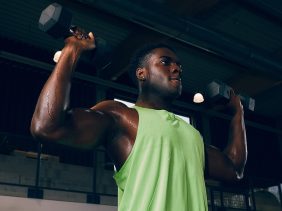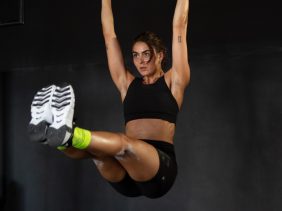Strength Training for Runners Made Easy
 © foodspring
© foodspring
Whether you’re an occasional runner, active hobby runner, or a competitive marathoner, strength training for runners will improve your health and performance. This article explains which muscles you should train, including two sets of the best strength and balance exercises for runners. The best thing is you don’t need a gym or a lot of equipment!
For many runners, strength training is a necessary evil that you do half-heartedly between two runs. Ambitious amateur runners, in particular, find it difficult to fit it in between lots of endurance sessions, their career, and social life…and that can have a substantial negative impact on their physical health and performance.
Strength training significantly improves your performance as a runner and deserves a fixed place in the training schedule of every (future) endurance athlete. If you combine jogging with strength training, you’ll be healthier and faster in the long run.
The extra session doesn’t have to take up a lot of time: a few strength exercises are always better than none. But the more seriously you take your running, the more seriously you should take your strength training as well.
Our tip: Not sure where to start? Have a look at our article on how to start jogging to get going on the right foot!Start jogging now
Why Strength Training Makes a Better Runner
Running involves strenuous, repetitive effort that should not be underestimated. With each step, your body feels the impact of 3-4 times your bodyweight. In order for your passive musculoskeletal system (bones, joints, ligaments, cartilage, intervertebral discs and other related connective tissues) to keep up, your active musculoskeletal system (the team of muscles, tendons, and fascia) must be well coordinated and work efficiently together.
Runners don’t train their whole bodies equally: Your legs have to work much harder than your upper body. As a result, some muscles get stronger and stronger, while the others fall behind. This creates lopsided strength, also called muscular imbalance.
Anyone who sits at a desk a lot or has a job with the same positions and movements all the time tends to develop such imbalances. With highly lopsided strain, these can worsen and lead to injury and damage to your joints. Your training, athletic career, and overall health all suffer. That’s why strength training is a must for runners.
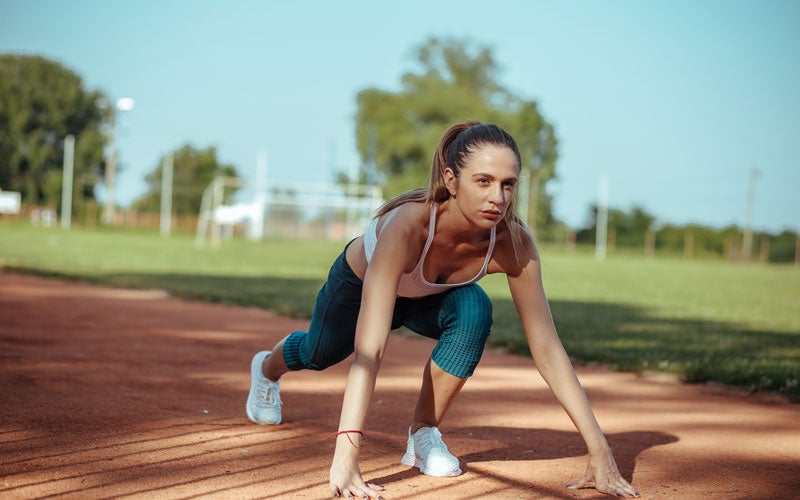
Strength training for runners – advantages
Regular running-specific strength training helps your active musculoskeletal system keep up the good work. At the same time, it reduces the risk of muscular imbalances.
Here’s how strength training makes runners better
- More accurate & healthier running style
- Lower risk of injury
- More efficient & powerful
- Better pace
- Muscle more resistant to fatigue
- Improved balance, discipline, and mental resilience
Other bonus points: A well-trained body just feels better. Plus, muscles increase your basal metabolic rate, which means you can eat more without gaining weight. Check out our healthy, delicious fitness recipes to find new meals that work for you!Discover our fitness recipes
Want to reach your feel-good weight with running? Calculate your calorie needs precisely and consume fewer calories than you burn, but not by too much. A calorie deficit that’s too high will keep you from having enough energy to get your heart rate up and ruin your metabolism in the long run.
3 Tips To Make Sure You Do Your Strength Training
No time, too exhausted, too sweaty, not really warmed up, 20 minutes of resistance training isn’t worth changing into your workout clothes for. These excuses sound familiar? Then it’s time to put them to rest. Here’s how to integrate strength training into your daily routine:
1. Make it a habit.
No time is ever just right. How much time a day do you spend on your smartphone or on the couch? Probably at least 20 minutes, which you could also invest in strength training exercises on at least 2 out of 7 days.
Pick a time when you can motivate yourself to do a little exercise. Whether it’s in the morning after you get up, during your lunch break at work, every Saturday, or before or after your usual running workout. Stick to this fixed time until it becomes a permanent part of your life.
2. Start small.
All or nothing will get you nowhere. Most of the time, this approach just builds up pressure and eventually leads to you doing nothing at all. 10 push-ups are better than none. Build up a routine that lasts just long enough to fit into your schedule. If you don’t do 3 sets of each exercise, but just one at first, that’s a lot more than just sitting on the couch. And your muscles will thank you for it!
3. Make a plan.
Thinking about new moves to do for 10 minutes every time is demotivating and makes it hard to get started. Avoid this quagmire by putting together a little routine of strength exercises for runners that you stick to.
Our 15 strength and balance exercises for runners are perfect for this. Do the 10 strength exercises one day, and when you have less time, do the 5 balance exercises for runners. They take a maximum of 10 minutes in total and are highly effective at building strength and body awareness.
Runners Should Train These Muscles
Running mainly strengthens the legs. Your hip muscles are also engaged to some extent. Since all other muscles, including your core and arms, are still involved in the movement, it’s technically a full-body exercise. Technically. But it’s still mostly your calves and the front and back of your thighs that have to work.
That’s why runners should target the muscle groups they use less to reinforce their strength, with upper body exercises, for example. The following groups are the most important:
Core muscles

A strong set of core muscles is the best prevention against typical runners’ injuries. You’re constantly shifting weight from one leg to the other during a run. During this motion it’s your core muscles that stabilize your torso and hips.
A strong core prevents compensatory movements, which can not only worsen overuse injuries, but also make the movement more inefficient and negatively impact your performance.
During a long run, the shock-absorbing function of the intervertebral discs gradually diminishes. Strong core muscles reduce your risk of back pain by helping cushion your body weight and smoothing out the impact on your passive musculoskeletal system.
Back muscles
The back extensor (erector spinae), lats (latissimus dorsi), traps (trapezius) and the rhomboids (rhomboideus major and minor) may seem to only be tangentially related to running, but they also fulfill an important role in your training.
Your back muscles stabilize your torso when you’re running. On the one hand, they prevent possibly damaging compensatory movements in the hip area and, on the other hand, they prevent energy from being lost through unnecessary rotation of the upper body. This saved energy means you’ll have a better pace.
But it’s not just runners, most people tend to have a rather weak back thanks to too-much sitting or bent-over postures, while at the same time the chest and abdominal muscles are tense. That’s why back training is always part of a good compensatory workout.
Hips and glutes

The hip flexor (iliopsoas), the hip-extending muscles on the back of your leg (ischiocrural muscles), and the glutes (especially gluteus maximus) must coordinate smoothly while running.
The large gluteus maximus muscle is mostly responsible for hip extension and momentum; only a fully extended hip and a powerful push-off allow you to run at a quick pace and with a clean and elegant style. To make this possible, your glutes must be strong and your hip flexor muscle flexible enough.
We’re sure you’ve seen runners who look like they’re running in a seated position. This posture results from weak glutes and a tight iliopsoas, and leads to knee, back, and hip pain as well as poor posture in the long run.
Thigh abductors
The thigh abductors consist of the smaller parts of the glutes: gluteus minimus, medius, and piriformis. The gluteus maximus and the external thigh muscle (tensor fasciae latae) are also involved in the lateral movement of the thigh away from the body (abduction). They stabilize the leg axis during a run and support an efficient running style. Hip abductors that are too weak are often the cause of runner’s knee.
Tip: Do your legs get wobbly during intense sessions? Boost your strength and energy with our Energy Aminos. The perfect mix of caffeine and BCAAs give you the power you need to keep going!Check out our Energy Aminos
Strength Training Exercises for Runners – 10 Moves for Better Running
If your primary sport is running, large, heavy muscles are counterproductive. Runners don’t use resistance training to increase muscle bulk, but focus on building strength endurance instead. Center your workout on functional training with running-specific exercises that also improve body awareness and inter- and intramuscular coordination, while helping prevent muscle imbalances. Our 10 strength exercises for runners will help you do just that.
1. Pistol squats
Hold onto an object at about waist height or attach a non-elastic rope or strong resistance band to a solid object. Stand firmly on your left leg, weight on your heel. Push your hips back and down slightly so that you come into a squat-like position. Lift your right leg as best you can. Ideally, your leg is extended and stays parallel to the floor. Now keep your core engaged and lower your hips further, until just above the floor. Push yourself back up using the strength of your left leg.
Do as many reps as you can with while still executing them cleanly. If you can do more than 12, increase the difficulty. Repeat for the other leg and do 3 sets in total.
Variations
- easier: Stand in front of a bench, wall, or box and lower your hips only until they touch it.
- harder: Do your pistol squats without holding on to anything. Don’t try this until you’re sure you can do it. To get there with a lower risk of injury, gradually minimize the amount of support you use.
2. Step-Ups
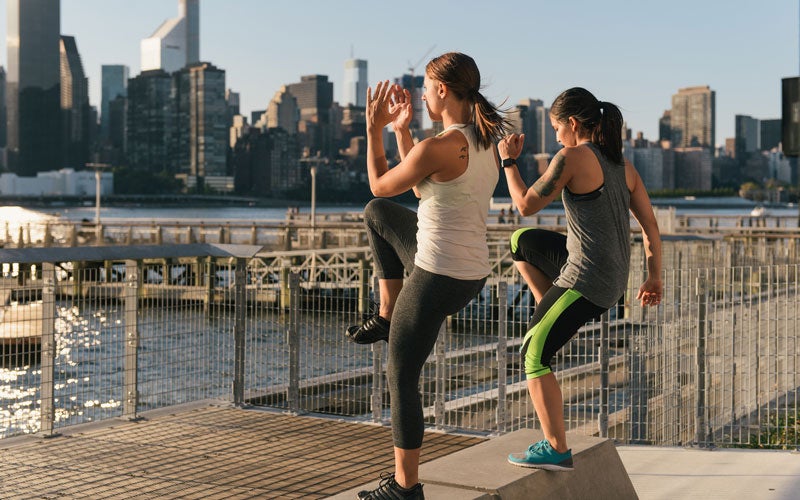
Instructions
For this exercise, find a wall, box, or sturdy bench that is at least knee-high. Hold your arms at an angle, like you would when running. Step up onto the box with your right leg so that your whole foot is firmly on the box. Push up, keeping your core engaged and pulling your left leg toward your chest as the right arm swings with you. Step back down and up again. Do about 12-15 reps before switching sides. 3 sets in total.
Variations
- easier: Use a lower step.
- harder: Carry weights in each hand. Make sure your upper body axis still remains straight and torso stable.
3. Squat walk with mini band

Instructions
Place the mini band so that it’s just below your knees. Lower into a medium-deep squat position, glutes just below your knees. Make sure your knees are pointing in the same direction as your toes instead of collapsing inward. Take five big steps forward and back, for a total of 3 sets.
Variations
- easier: use a weaker mini band or bring your hips a little higher.
- harder: use a stronger miniband, hold a weight, or increase the speed of your steps slightly without sacrificing leg stability.
4. Bent leg abduction with mini band
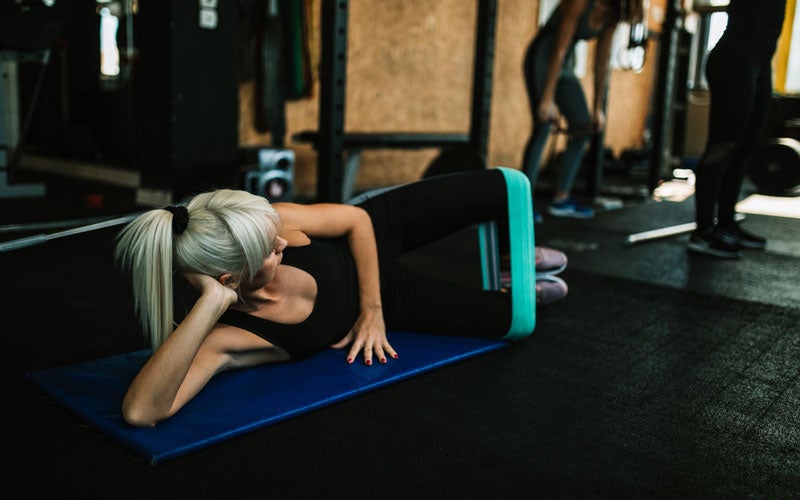
Instructions
Place the mini band around your thighs at about the midpoint between knee and hip. Lie on your right side. Ear, shoulder, hip, and knee form a straight line. Lower legs are bent, the angle at the knee is about 90°. Keep your feet together, engage your core, and now slowly raise your knee up and back down. 15 reps per side, 3 sets in total.
Variations
- easier: Use a lighter mini band or don’t use one at all.
- harder: Use a stronger mini band. Nothing is difficult enough? Then prop yourself up on your forearm, elbow under your shoulder, and push your torso into a side plank. Keep your body up throughout the leg movement.
5. Glute Bridge
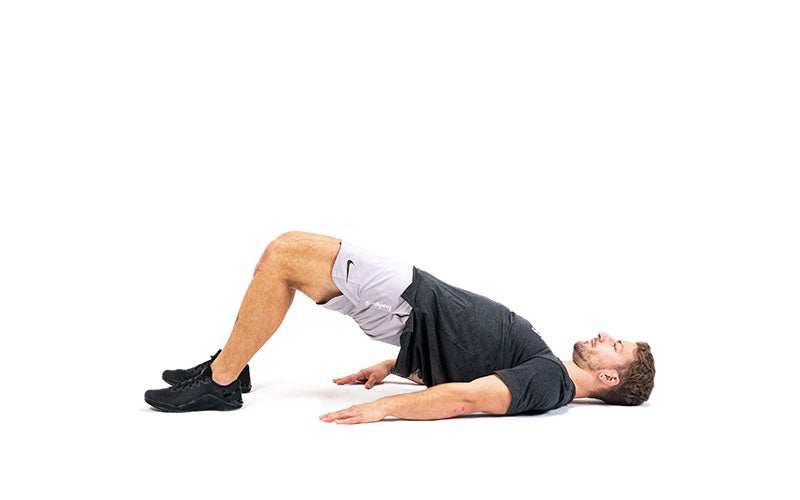
Instructions
Lie with your back flat on the mat. Place your feet hip-width apart with your knees bent. Make sure the distance between your knees remains the same throughout the movement.
Now lift your hips up until your spine, hips, and thighs form a straight line. To fully exercise the back extensor, raise your shoulder blades slightly. Note: Don’t cheat with your arms – your strength comes from your core, legs, glutes, and lower back.
Then slowly lower your hips back down to just above the floor. Just before touching the floor completely, push yourself back up. 15 reps, 3 sets.
Tip: This exercise is especially effective for the entire back of your body. But it’s also more complex than it sounds. Learn everything you need to know about this move in our article on the glute bridge – from the correct technique to detailed instructions.
Variations
- easier: If you can’t lift your hips up any other way, help your core out a bit with your arms. Reduce the number of repetitions until you can complete three sets.
- harder: Place a weight plate or other weights on your pelvis. Raise your pelvis slowly and stabilize the weights with your hands.
6. Plank: Hold + Lateral Rotation

Instructions
Start in a plank on your forearms with your core engaged. Your whole body forms a straight line, forearms are parallel. Slowly count to three in this low plank position. Then move your right forearm parallel to the front edge of the mat, turn to the side and, on the outside of your right foot, into a side plank. Left arm stretches straight up to the ceiling, push your hips up to stay in a straight line. Slowly come back to the forearm plank, count to 3 again, then repeat for the other side. 10 reps per side, 3 sets.
Variations
- easier: Rest your knees on the mat. Make sure your body still forms a straight line from your shoulders to hips.
- harder: Take a dumbbell in each hand, stretching your arm upward with each.
7. Swimmers
Instructions
Lie on your stomach, forehead facing the mat. Arms stretch forward next to your ears, thumbs up, shoulders pulling down from your ears. Legs and feet are actively extended with the tops of your feet on the floor, core engaged, hips pushing into the floor. Now lift your forehead minimally off the floor and raise your left arm and right leg simultaneously. While you’re lowering them, already start lifting the other diagonal pair, so that, for a small moment, neither of your arms or legs are on the floor. 10 reps per side, 3 sets.
Variations
- easier: Keep your forehead on the floor and lower one diagonal pair before lifting the other.
- harder: Increase the speed while still keeping your hips on the floor.
8. Heel Tap Crunches

Instructions
Lie on your back, knees bent, and feet planted close to your pelvis. Look straight up with your neck long. Arms are extended by your sides, fingers pointing toward your feet, palms up toward the ceiling. Lift your shoulder blades minimally off the floor, tense your core, and pull yourself to one side until you can tap your heel with your hand. 15 reps for each side, 3 sets.
Variations
- easier: bring feet closer to you, briefly rest your shoulders after each rep to relax
- harder: place feet further away from you, move slower.
9. Mountain Climbers
Instructions
Begin in a high plank position, micro-bend in your elbows, fingers pointing straight ahead. Now pull one knee as close to your chest as you can. As you do this, round your back. Switch legs. Go as fast as you can for 3 sets of 45 seconds a piece. Hips remain in line with your shoulders or slightly lower as you move in and out of plank position.
Variations
- easier: Slow the movement down.
- harder: Move so quickly that your feet leave the ground completely.
10. (Spider) Push-Ups
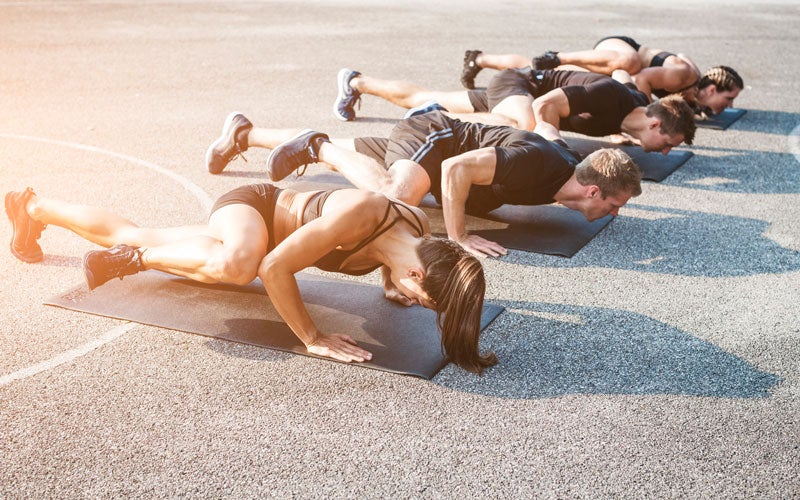
Instructions
Come into a high plank position. Bend your arms into a push-up, elbows pointing back, upper arms close to your body. In the low position, pull your right knee up toward your elbow, keeping your core engaged. Stretch your leg back and push back up into a high plank. On the next push-up, pull your left knee to your elbow. 5 reps per side, 3 sets.
Variations
- easier: Rest your knees on the floor in the plank.
- harder: Pull each knee up once while lowered. Alternate the starting leg.
5 Balance Exercises for Runners – 10-Minute Routine
One-leg Superman
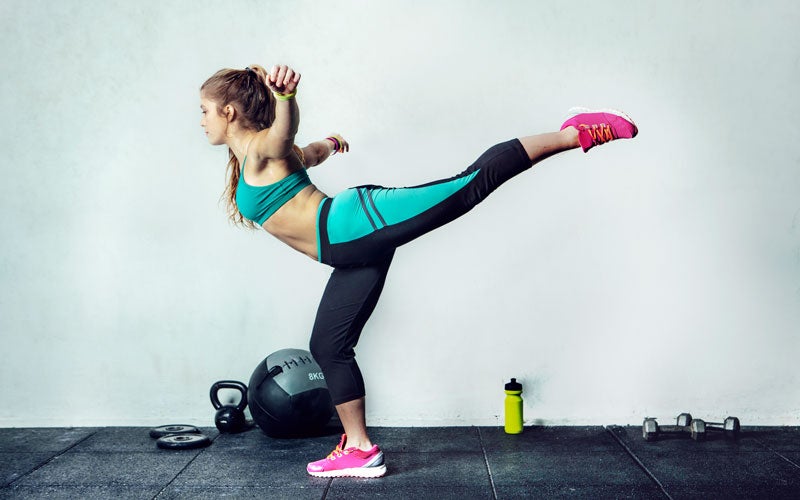
Instructions
Stand in a hip-width stance. Bend your left leg minimally and shift your weight to your left foot. Arms are extended to your sides, palms facing down. Shift your weight forward until your upper body is parallel to the floor. At the same time, extend your right leg back.Torso and right leg should stay in a straight line the entire time. Try to keep your balance for 5-10 seconds on each side. 2 sets.
Variations
- easier: Stand in front of a stable object, hold onto it with your hands at shoulder height and stabilize yourself.
- harder: Extend your arms upward, palms facing each other. Then in the final position, arms, torso, and legs form a straight line.
Lunges on an unstable surface
Instructions
Lower yourself into a normal lunge position, with your front foot on a wobbly object, such as a rolled blanket or a wobble board. Now slowly do your lunges, keeping your core engaged, trying to keep the front knee in line with your ankle both laterally and frontally. 10 reps per side, 3 sets.
Variations
- easier: Use a more stable surface.
- harder: Use a less stable surface or close your eyes.
Single leg balance on an unstable surface
Instructions
Stand with your feet on an unstable surface. Then lift one foot, tense your core, and try to stay stable. By the way, you can also do this exercise perfectly while brushing your teeth or at a bus stop. If there is no unstable surface, close your eyes instead.
Variations
- easier: Use a more stable surface.
- harder: Use a less stable surface or close your eyes as well.
Tiptoe rises
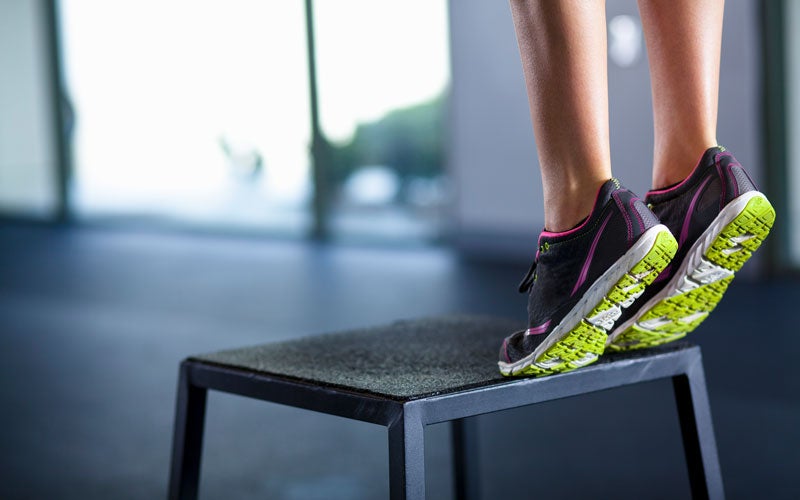
Instructions
Stand normally. Lift your heels off the floor until your ankles are extended. Try to balance here as long as you can. This exercise is also a great pastime at the bus stop.
Variations
- easier: Don’t go up as high on your tiptoes.
- harder: Close your eyes, add weights or stand on an unstable surface.
Lunge with Rotation
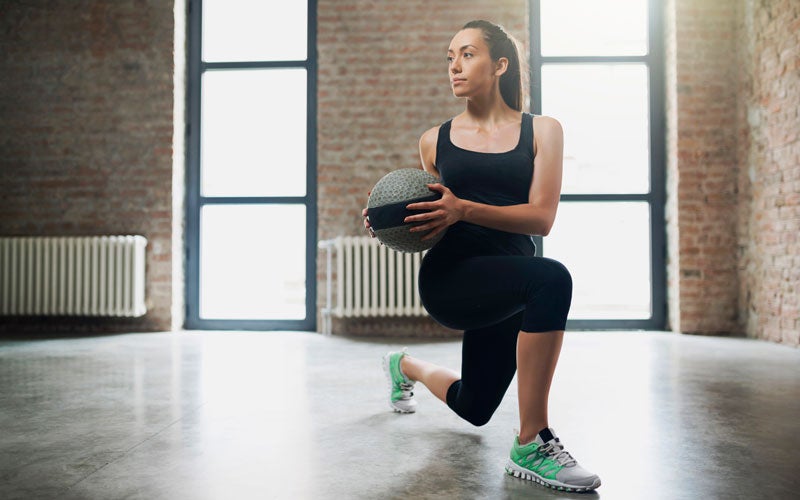
Instructions
Stand with your feet in a lunge position with your back knee resting on the mat as far back as it can go. Try not to put too much weight on your knee, keeping the core and thighs active. You can also cushion your knee with a folded mat or towel.
Front knee is at 90 degrees, knee and ankle form a line laterally and frontally. Now extend your arms out to the sides at shoulder height and slowly rotate your upper body toward your front leg and back. 5 reps per side.
Variations
- easier: Place your hands on your hips.
- harder: Keep your knee raised off the floor and add weights.
Take note: All these exercises are new territory for you? Then let a trainer or experienced athlete show you how to do them properly. For all moves, proper technique and full range of motion are more important than speed, resistance bands, or number of repetitions. Even for experienced athletes it’s helpful to have your movement quality checked from time to time.
Running and strength exercises – a mismatch?
In principle, well-structured hypertrophy training can have benefits for runners. However, since this should be integrated sensibly into a training plan and competition prep, taking into account recovery times and personal goals and requirements, it’s not appropriate to make general recommendations.
If you’re an ambitious runner and want to get the most out of your strength training, it’s best to discuss your plan with a specialized coach.

Strength Training Before or After a Run?
The workout that’s higher priority comes first. The strain on your body from an intense workout with lots of reps requires concentration and full capacity, which aren’t as robust after strength training or an intense run.
Focusing on running today? Then run first, get your heart rate up, and do a simple strength workout after. Today is strength day? Then do your strength training first and an easy run afterwards.
As a beginner, it’s best to schedule your strength training for runners on separate days at first so your body has enough time to recover after the strain.
As a general rule, you shouldn’t schedule two intense sessions for one day. If you want to combine your exercises with a run, plan your workout for after a relaxed endurance run, for example, or a shorter workout that didn’t challenge you too much.
Strength Exercises for Runners – Workout Plan
The details of your strength training plan for runners, and what exercises it should include, depend on your health and physical conditioning as well as your running goals.
Many runners just set out to do running-specific strength training 2 times a week. Sometimes this is easier than complicating it with strength training exercises in a multi-day plan. If you’re running healthy and pain-free and incorporating our 15 exercises into your training 2 times a week, that’s perfect.
2x a week doesn’t work for you? You can also do 2-3 moves first thing every morning. The most important thing is that you integrate strength training moves firmly into your everyday life.
Take note: The combination of a running-specific strength training routine and running is exhausting. Be sure to give yourself 24-48 hours of recovery time after intense sessions. If you want to keep moving, these 5 foam roller exercises are perfect for active recovery.
Strength training for runners who compete regularly is best planned around the competition season. Targeted hypertrophy training can be a particularly good idea for the off-season, and then your focus is back on running during the season.
Conclusion
- Strength workouts are essential to reduce your risk of injury.
- Running-specific strength exercises and stability training will make you a better runner.
- Make strength training exercises for runners a routine.
- Little is better than nothing: Don’t put yourself under pressure and schedule your strength training on fixed dates.
- Strength training exercises are best done after a relaxing cardio workout or on a day off from running.
- Learn to do each exercise correctly at least once.
Sources for this article
We at foodspring use only high-quality sources, including peer-reviewed studies, to support the facts within our articles. Read our editorial policy to learn more about how we fact-check and keep our content accurate, reliable, and trustworthy.



























